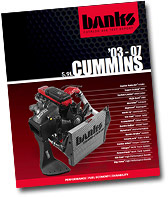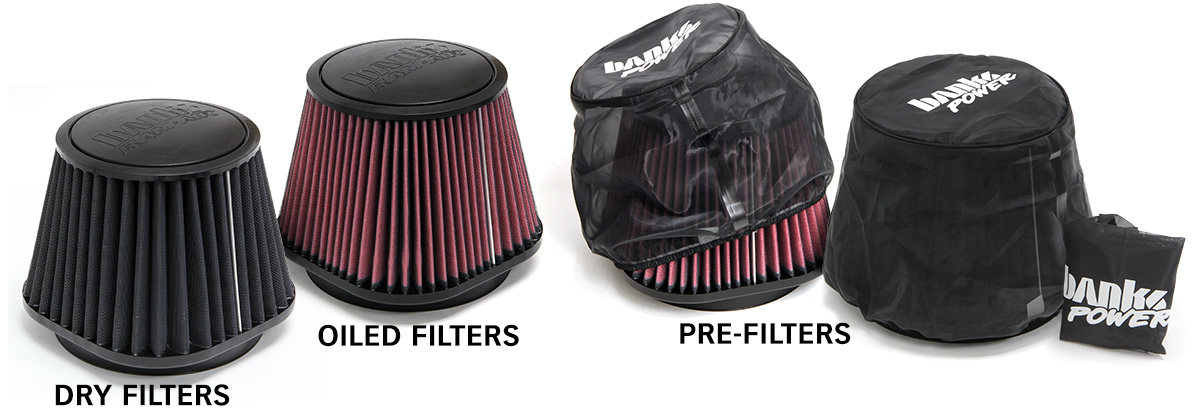6 Intakes Flunked Banks Density Test!
6 out of 7 “cold air” systems provide LESS air density to the turbo inlet than the stock
system! That sucks for our competitors, because air density is the key to better performance.
MORE DENSITY = MORE MPG AND HP.
It’s good to be dense, all right. Check out our density ad for an informative look at
intake airflow, air temperature and air density, and how they all come together in the Banks Ram-Air Intake.
Bankspower.com/density ad
Testing so good, it’s patented! Banks sets uncompromisingly high standards for testing. In
fact, we were awarded an Engine Performance Evaluation patent from the United States Patent and Trademark Office.
Check it out: Engine Performance
Evaluation: US Patent # 7,254,477


Overview Summary
We measured each intake’s effect on air density at the turbo compressor inlet. Intake temperatures will
generally be higher than ambient conditions, but the more the system can duct cool air to the filter and
preserve the cool temperature as the air is ducted to the turbo, the higher the air density will be. In
addition, there will commonly be a pressure drop as air travels through the filter and the ducting due to
any restriction that is introduced. If the design of the system can minimize the restriction and the
pressure loss, air density will be preserved.
Test Setup
A 2004 Dodge Ram 2500 4X4 Quad Cab Long Bed with the Cummins 5.9L engine and automatic transmission was used
as the test vehicle. A data acquisition system was used to measure vehicle speed via GPS, along with
multiple temperature thermistors and extremely accurate pressure transducers. The total vehicle weight was
approximately 19,000 lbs. Tests were run in 2WD.
Testing was conducted on a moderate hill on the northbound CA-57 in the city of Pomona. Speed was maintained
at 45 MPH until the vehicle was adjacent to a pre-determined start point on the road. At that point, the
accelerator was fully depressed and the vehicle was allowed to accelerate while climbing the hill. Test data
was observed at the same vehicle speed in all cases, with the engine at 2800 RPM, the point of peak engine
power. This data point occurred between 60 and 90 seconds into the run—sufficient time to allow the engine
to reach a stabilized operating condition.
Data Acquisition
Vehicle Speed, Engine RPM and Accelerator Pedal Position were logged to determine the load conditions and speeds.
Temperature was measured using thermistors for increased accuracy. They were mounted to measure ambient
temperature as well as temperatures at the filter and compressor inlets. Pressure transducers were used to measure
pressure in the same locations. The intake system effect on air density was evaluated by comparing the temperature
and pressure of the ambient air condition with the temperature and pressure of the air at the turbo compressor
inlet.
All intake filtering systems will have some effect of diminished air density from ambient, including stock. The
purpose of this evaluation is to compare this effect in relationship to the stock system. A replacement intake
system is only valuable and effective if the intake air density percentage vs. ambient is greater than the air
density percentage offered by the stock system.
Test Results
Stock Intake
- Elevated ambient air temp 17.7° F
- Lowered air pressure 6.8%
- Combined result: air density 90.2% of ambient
Banks Ram-Air
Replaces the stock setup with new housing, filter with 7.5” outlet, lid & ducting system made of
cross-linked polyethylene & polypropylene, all the way to the inlet of the turbo compressor. Inlet to filter
housing is sealed to the fender air duct with open-cell foam.
- Elevated ambient temp just 12.3° F
- Air pressure 3.9% lower than ambient
- Combined result: air density 93.9% of ambient
AEM Brute Force Intake
Replaces the stock setup with an aluminum tube, dry filter & a sheet metal heat shield. Filter has a 4”
outlet which mates to the aluminum tube.
- Elevated ambient temp 52.6° F (2nd highest increase of the group tested)
- Could be attributed to the aluminum tube transferring underhood heat into the intake air
- Lowered air pressure 1.8%
- Combined result: air density 89.5%
- 0.7% worse than stock
- 6.5% worse than Ram-Air with Super-Scoop
- Installation would result in a power loss
AFE Stage I and Stage II
Both systems use a filter with a 6” outlet. Stage I leaves the filter exposed with a sheet metal heat
shield.
- Elevated ambient temp 49.4° F
- Lowered air pressure 2.7%
- Combined result: air density 89.1% of ambient
- 1.1% worse than stock
- 6.9% worse than Banks
- Installation would result in a power loss
Stage II has a fully enclosed housing with an integrated forward-facing scoop.
- Elevated ambient temp 27.9° F
- Pressure 3.0% less than stock
- Combined result: air density 92.2% of ambient
- 2.0% better than stock
- 3.8% worse than Banks
Airaid Intake System
Quick-fit system filter mounts to an adapter that mates to the factory inlet duct with a 3.75” inside
diameter.
- Elevated ambient temp 26.8° F
- Lowered air pressure 5.5%
- Combined result: air density 90.1% of ambient
- 0.1% less than stock
- 5.9% worse than Banks
- Installation would result in a power loss
Bullydog RFI
Sheet metal enclosure with an opening toward the factory fenderwell opening. Filter is mated to a section of
elbow tubing that mates to the factory bellows & silencer.
- Elevated ambient temp 19.3° F
- Lowered air pressure 8.3% (only system tested that produced a lower effective air pressure than the stock
system)
- Combined result: air density 88.5% of ambient
- 1.7% worse than stock
- 7.5% worse than Banks
- Installation would result in a power loss
Volant Cool Air Intake
Oval-shaped filter housed in an enclosed box with three openings: one at the bottom, one toward the front &
one toward the fender.
- Despite website claims that Volant is the “only true cool air design,” it elevated the ambient temp by 50.5°
F—among the highest of the systems tested!
- Lowered air pressure 3.2%
- Combined result: air density 88.2% of ambient
- 2.0% less than stock
- 7.8% worse than Banks
- Installation would result in a power loss

Here's the TEST REPORT
for your vehicle!
View it right now online »
NEW FILTER OPTIONS! Choose from the traditional red, oiled filter or the all-new
black, dry filter. Plus, you can even get an extra layer of filtration protection by adding a pre-filter to
your order.


























